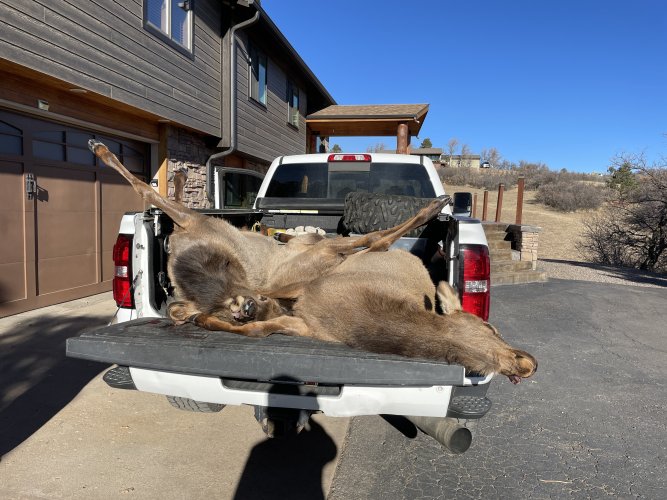TTSX or TAC-TX? TAC-TX is the .300 BLK barrier-blind round specifically designed for that gun.Yeah I saw an elk this year killed with a 120 gr Barnes TTSX out of a .300 blackout. Went through and lodged under the skin of the opposite shoulder at 100 yds. Bull ran 60 yds and died. Certainly not a caliber that I would ever choose, but the performance of the mono bullet was quite impressive.
Navigation
Install the app
How to install the app on iOS
Follow along with the video below to see how to install our site as a web app on your home screen.
Note: This feature may not be available in some browsers.
More options
You are using an out of date browser. It may not display this or other websites correctly.
You should upgrade or use an alternative browser.
You should upgrade or use an alternative browser.
Forget caliber and bullet, let’s talk shot placement
- Thread starter El Jason
- Start date
El Jason
Well-known member
Which is what most people do with shot placement. 4 elk died from a well placed 243 bullet. Not sure what more thinking needs to go into that.Or underthink shit.
KingOfTagSoup
Well-known member
- Joined
- Nov 29, 2022
- Messages
- 277
TTSX handloadsTTSX or TAC-TX? TAC-TX is the .300 BLK barrier-blind round specifically designed for that gun.
LuketheDog
Well-known member
4 elk died from a well placed 243 bullet. Not sure what more thinking needs to go into that.
That's impressive, I saw 3 die from a well-placed Chevy 2500 last week. Someone got lucky (or unlucky, depending on how you look at it) and scored head, broadside, and quartering away shots all at once, penetration sucked but the job got done...my neighbor and all his retired pals were thrilled.

OntarioHunter
Well-known member
- Joined
- Sep 11, 2020
- Messages
- 5,997
I suppose if I could always rely on my ability to place the bullet, I might try shooting elk with fast little copper bullets. I am a good shot. Or I was anyway. As I have aged and fallen apart, so has my ability to shoot (albeit relatively slightly). In Africa this past year I noticed my legs were much more unsteady (bad circulation is no doubt the culprit). It did affect my ability to shoot, even on the sticks. Did better later in Montana but by then I was in better shape from bird hunting and wearing support stockings. Anyway, besides my old age shakiness, there's a multitude of factors that can alter the well intended placement of a shot in an elk. At the top of the list is the elk might move just as the gun is fired. That may not move the point of impact far, but with a small bullet it might be far enough to result in only wounding and/or a difficult tracking job to find the elk. And there are other factors to consider: wind (especially when shooting light bullets), debris, and distance. So, even if the shooter is confident in his abilities and familiar with his gun, he should use a caliber and cartridge that will expand the margin for error rather than restrict it. Personally, I never before heard of anyone hunting elk with a .243. It requires too much precision to be regularly effective on them. I think anyone shooting at a moving elk with a .243 should have his license taken away. The shooter can be as precise as Annie Oakley but the environment in the field is not as static as it is at the range and an elk is not made of paper. Shot placement is important, but the shooter needs to accept there are factors affecting shot placement that are beyond his ability to control. Select a cartridge that gives some leeway for the unexpected.Which is what most people do with shot placement. 4 elk died from a well placed 243 bullet. Not sure what more thinking needs to go into that.
Last edited:
Exactly!It seems we have ad nauseum conversation and debate about what is the best caliber to get a blood trail out of an elk. Followed up by, what is the best bullet to get a blood trail out of an elk.
It’s been my experience over the years that shot placement is far more important than either the heads stamp, or the type of bullet being used in terms of a short recovery on an elk.
In order to find the ideal aiming spot for a fast kill, do the following:
1. imagine a vertical line that is perfectly centered between the two front legs
2 for your horizontal hold imagine the body cavity is divvied up into quarters. Go slightly above 1/4 of the way up that vertical line.
You can go higher than this if you want to, but absolutely do not go above the halfway point of the body. The further away you get from that 1/4 horizontal hold, you are still in double lung territory, but the amount of vasculature is greatly reduced relative to the lower hold. View attachment 252966View attachment 252967View attachment 252968View attachment 252969
Hockaday2017
Active member
High Shoulder with a rifle every time...
Hunter4Life78
Well-known member
- Joined
- Sep 4, 2022
- Messages
- 1,151
You @$$&!/3..Now how would feel if someone shot you while you were getting some loving?? Quote from Old Man when I asked what he would do if this situation presented itself. Still laugh when I see his facial expression.View attachment 252989
There's a lot going on here but stay focused
Hunter4Life78
Well-known member
- Joined
- Sep 4, 2022
- Messages
- 1,151
The elk in Montana don't have those red dots. It would sure make seeing them easier, the red really stands out in the snow
Similar threads
- Replies
- 3
- Views
- 661
- Replies
- 1
- Views
- 296




